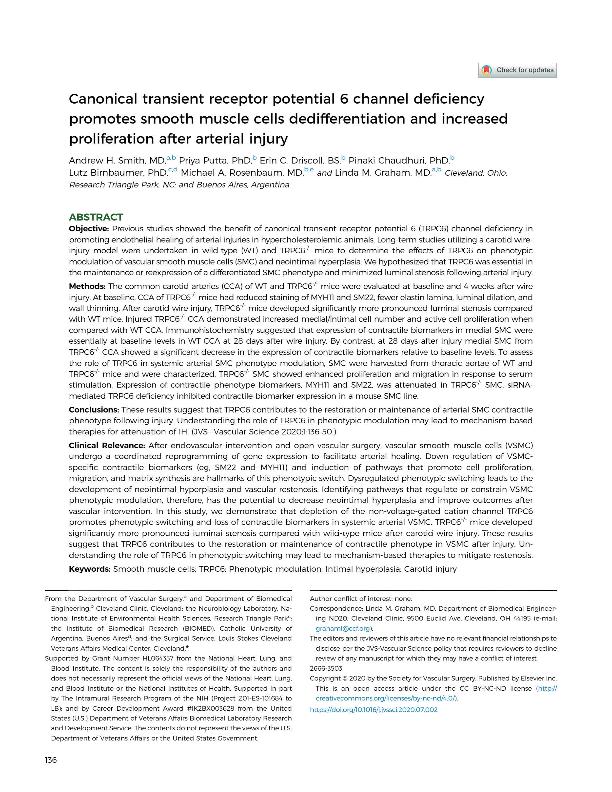Mostrar el registro sencillo del ítem
dc.contributor.author
Smith, Andrew H.
dc.contributor.author
Priya, Bhanu Priya

dc.contributor.author
Driscoll, Erin C.
dc.contributor.author
Chaudhuri, Pinaki
dc.contributor.author
Birnbaumer, Lutz

dc.contributor.author
Rosenbaum, Michael A.
dc.contributor.author
Graham, Linda M.
dc.date.available
2021-09-28T14:49:51Z
dc.date.issued
2020-07
dc.identifier.citation
Smith, Andrew H.; Priya, Bhanu Priya; Driscoll, Erin C.; Chaudhuri, Pinaki; Birnbaumer, Lutz; et al.; Canonical transient receptor potential 6 channel deficiency promotes smooth muscle cells dedifferentiation and increased proliferation after arterial injury; Elsevier; Vascular Science; 1; 7-2020; 136-150
dc.identifier.issn
2666-3503
dc.identifier.uri
http://hdl.handle.net/11336/141716
dc.description.abstract
Objective Previous studies showed the benefit of canonical transient receptor potential 6 (TRPC6) channel deficiency in promoting endothelial healing of arterial injuries in hypercholesterolemic animals. Long-term studies utilizing a carotid wire-injury model were undertaken in wild-type (WT) and TRPC6-/- mice to determine the effects of TRPC6 on phenotypic modulation of vascular smooth muscle cells (SMC) and neointimal hyperplasia. We hypothesized that TRPC6 was essential in the maintenance or reexpression of a differentiated SMC phenotype and minimized luminal stenosis following arterial injury. Methods The common carotid arteries (CCA) of WT and TRPC6-/- mice were evaluated at baseline and 4 weeks after wire injury. At baseline, CCA of TRPC6-/- mice had reduced staining of MYH11 and SM22, fewer elastin lamina, luminal dilation, and wall thinning. After carotid wire injury, TRPC6-/- mice developed significantly more pronounced luminal stenosis compared with WT mice. Injured TRPC6-/- CCA demonstrated increased medial/intimal cell number and active cell proliferation when compared with WT CCA. Immunohistochemistry suggested that expression of contractile biomarkers in medial SMC were essentially at baseline levels in WT CCA at 28 days after wire injury. By contrast, at 28 days after injury medial SMC from TRPC6-/- CCA showed a significant decrease in the expression of contractile biomarkers relative to baseline levels. To assess the role of TRPC6 in systemic arterial SMC phenotype modulation, SMC were harvested from thoracic aortae of WT and TRPC6-/- mice and were characterized. TRPC6-/- SMC showed enhanced proliferation and migration in response to serum stimulation. Expression of contractile phenotype biomarkers, MYH11 and SM22, was attenuated in TRPC6-/- SMC. siRNA-mediated TRPC6 deficiency inhibited contractile biomarker expression in a mouse SMC line. Conclusions These results suggest that TRPC6 contributes to the restoration or maintenance of arterial SMC contractile phenotype following injury. Understanding the role of TRPC6 in phenotypic modulation may lead to mechanism-based therapies for attenuation of IH. Clinical Relevance After endovascular intervention and open vascular surgery, vascular smooth muscle cells (VSMC) undergo a coordinated reprogramming of gene expression to facilitate arterial healing. Down regulation of VSMC-specific contractile biomarkers (eg, SM22 and MYH11) and induction of pathways that promote cell proliferation, migration, and matrix synthesis are hallmarks of this phenotypic switch. Dysregulated phenotypic switching leads to the development of neointimal hyperplasia and vascular restenosis. Identifying pathways that regulate or constrain VSMC phenotypic modulation, therefore, has the potential to decrease neointimal hyperplasia and improve outcomes after vascular intervention. In this study, we demonstrate that depletion of the non-voltage-gated cation channel TRPC6 promotes phenotypic switching and loss of contractile biomarkers in systemic arterial VSMC. TRPC6-/- mice developed significantly more pronounced luminal stenosis compared with wild-type mice after carotid wire injury. These results suggest that TRPC6 contributes to the restoration or maintenance of contractile phenotype in VSMC after injury. Understanding the role of TRPC6 in phenotypic switching may lead to mechanism-based therapies to mitigate restenosis.
dc.format
application/pdf
dc.language.iso
eng
dc.publisher
Elsevier

dc.rights
info:eu-repo/semantics/openAccess
dc.rights.uri
https://creativecommons.org/licenses/by-nc-nd/2.5/ar/
dc.subject
CAROTID INJURY; INTIMAL HYPERPLASIA; PHENOTYPIC MODULATION; SMOOTH MUSCLE CELLS; TRPC6.
dc.subject.classification
Biología Celular, Microbiología

dc.subject.classification
Ciencias Biológicas

dc.subject.classification
CIENCIAS NATURALES Y EXACTAS

dc.title
Canonical transient receptor potential 6 channel deficiency promotes smooth muscle cells dedifferentiation and increased proliferation after arterial injury
dc.type
info:eu-repo/semantics/article
dc.type
info:ar-repo/semantics/artículo
dc.type
info:eu-repo/semantics/publishedVersion
dc.date.updated
2021-09-27T15:25:10Z
dc.journal.volume
1
dc.journal.pagination
136-150
dc.journal.pais
Estados Unidos

dc.description.fil
Fil: Smith, Andrew H.. National Institute Of Environmental Health Sciences; Estados Unidos
dc.description.fil
Fil: Priya, Bhanu Priya. National Institute Of Environmental Health Sciences; Estados Unidos
dc.description.fil
Fil: Driscoll, Erin C.. National Institute Of Environmental Health Sciences; Estados Unidos
dc.description.fil
Fil: Chaudhuri, Pinaki. National Institute Of Environmental Health Sciences; Estados Unidos
dc.description.fil
Fil: Birnbaumer, Lutz. Pontificia Universidad Católica Argentina "Santa María de los Buenos Aires". Instituto de Investigaciones Biomédicas. Consejo Nacional de Investigaciones Científicas y Técnicas. Oficina de Coordinación Administrativa Houssay. Instituto de Investigaciones Biomédicas; Argentina
dc.description.fil
Fil: Rosenbaum, Michael A.. National Institute Of Environmental Health Sciences; Estados Unidos
dc.description.fil
Fil: Graham, Linda M.. National Institute Of Environmental Health Sciences; Estados Unidos
dc.journal.title
Vascular Science
dc.relation.alternativeid
info:eu-repo/semantics/altIdentifier/url/https://linkinghub.elsevier.com/retrieve/pii/S2666350320300134
dc.relation.alternativeid
info:eu-repo/semantics/altIdentifier/doi/http://dx.doi.org/10.1016/j.jvssci.2020.07.002
Archivos asociados
